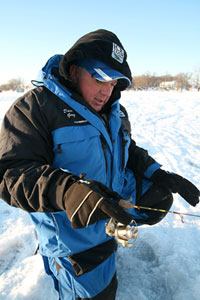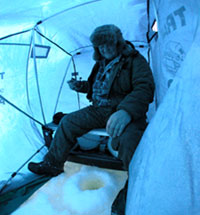 For all the ice fishing he had done up to that point, Dave Genz had never felt so baffled by bluegills. This was back in the early 80s, down (for him) in Iowa, on Emerson Bay of Lake Okoboji.
For all the ice fishing he had done up to that point, Dave Genz had never felt so baffled by bluegills. This was back in the early 80s, down (for him) in Iowa, on Emerson Bay of Lake Okoboji.
It’s a funny story how he ended up down there in the first place. In those days, he was selling his invention, the Fish Trap, out of his garage. Word was getting out about those instant setup portable shelters, and serious ice fishermen wanted one. Led by Mike Salzman, who came to be known as ‘Iowa Mike,’ a customer cluster formed in the Spirit Lake area.
“There were a lot of people in that one area who wanted the mobility, and that kind of house,” remembers Genz. “I volunteered to drive down there with a bunch of Fish Traps if they had a farm pond for us to fish.”
Actually, a small contingent from Minnesota, early adopters of the Winter Fishing System, ended up going with Genz on this delivery-slash-fishing adventure.
“Us Minnesota boys with the electronics caught all the fish,” Dave says, setting himself up for what comes next. “We went to this farm pond, and we were all using flashers, and it was the kind of fishing we were used to.”
Iowa Mike and his friends, who were not using Vexilars, did not catch as many.
“We stayed over, and the next day we went to Emerson Bay on Lake Okoboji, and those guys told us we weren’t going to catch any fish,” says Genz. “We felt pretty cocky, I assure you. We got out there on the lake before daylight and I had three nice bluegills on the ice by the time the sun came up, and then it was over and I never caught another fish.
“The local boys proceeded to fill their pails.”
You didn’t get to where Genz was in the ice-fishing world, even at that time, by backing down from a challenge. Here he was, humbled by big bluegills that other people could catch and he couldn’t.
“I knew there was something to learn,” he says, “so I moved the Trap Attack down there.” (At that time, it was a single annual event, run by his family.)
Several important developments came as a result. Genz, who had almost exclusively fished stained water fish with the aid of a depthfinder, was suddenly immersed in the world of sight fishing. Okoboji is crystal clear, with fish that have all day to examine potential food items. Like all fish in clear water environments, they rely on vision to a larger degree than fish in stained or dirty water.
At first, Genz admits, he thought the panfish of ‘Boji were somehow different than the fish he routinely slew in Minnesota and Wisconsin lakes.
“I had fished more stained-water lakes than anything else,” he says, “and didn’t fish in the weeds much. In those days, we had many lakes where we could find (bluegills, crappies, walleyes, perch) outside the weeds.”
Looking back on it now, Genz understands how easy it is to believe the fish from a certain region, or even one lake, are “different than the fish you are comfortable with in your local area,” and how such legends are born and come to be accepted as part of the fishing pipeline. The bluegills of Okoboji were thought of as super intelligent creatures for a time, and long stories were told and re-told around Genz’s kitchen table about what it took to catch them.
 As it turns out, they are simply fish from ultra-clear water, fish that take advantage of the fact that they can see well. They sidle up and examine potential prey, and they refuse things that don’t look real to them. But any fish in any other ultra-clear water environment learns to do the same thing. Encounter sunfish in a super-clear lake in Michigan and they act the same way.
As it turns out, they are simply fish from ultra-clear water, fish that take advantage of the fact that they can see well. They sidle up and examine potential prey, and they refuse things that don’t look real to them. But any fish in any other ultra-clear water environment learns to do the same thing. Encounter sunfish in a super-clear lake in Michigan and they act the same way.
“We learned the value of a horizontal presentation by catching nothing on our vertical jigs the first time (at Okoboji),” Genz says.
“We ended up being good friends with Iowa Mike and his buddies, and we ended up sharing lots of ideas. It was one of the best things that ever happened to us.”
Ice jigs with a horizontal attitude, like the Fat Boy and Genz Worm, are important weapons in clear water. Jigs like the Genz Bug– which often rides at an angle somewhere between horizontal and vertical– can also be great clear-water baits.
A key in any clear-water environment is to present something that looks like it’s swimming smoothly, or kicking rapidly, with a horizontal posture. (In fact, that smooth horizontal presentation has come to be known as the ‘Okoboji Swim’ among ice insiders.) Tip those jigs with lively maggots or wax worms and you have a proven combo. More recently, plastic tails like the Techni-Glo and Munchies Tiny Tails from Lindy have found a growing fan base among clear water ice anglers. (The Pin Tail, in particular, has an undulating action that’s very effective in such situations.)
It became important for Genz and his friends to realize the bluegills of Okoboji were not mystical creatures, but rather just bluegills that needed to be convinced something was real before eating it. In time, the Minnesota boys did just fine fishing side by side with Iowa Mike. (Although, truth be told, Mike could panel his den with the wooden plaques he has won at the Iowa Trap Attack, fishing against all comers.)
The point of this whole long-winded tale is to urge ice anglers not to believe their fish are somehow different than the fish a couple hundred miles down the road.
Fish living in similar environments will act similarly.
Water clarity is one of the most important factors determining location and feeding behavior in fish. Presence or absence of weeds is another important factor. Location of food (tied to both of these factors) is another.
Learn to fish stained water lakes and you can be successful on stained water lakes no matter where you go. Learn to perform the Genz Pound presentation with a horizontal jig and you can fool clear water bluegills no matter how far you travel.
Learn to fish walleyes in bowl-shaped lakes featuring few structural elements and you can be successful in any similar fishery anywhere. Learn to catch pike in the weeds and you will catch pike in the weeds wherever they are found. There is an old saying that fish are fish, no matter where they swim. That’s a simplistic way of looking at it. More accurately, fish are fish, and they tend to behave the same when they are found in similar bodies of water.
It can be easy to get sucked in to the notion that your fish are somehow different than somebody else’s fish. They aren’t.
Remember that. It doesn’t make for as many fascinating stories, but here is one of the universal truths about fishing: It’s the habitat fish live in that determines where they go and what they do.
Note: Dave Genz, known as Mr. Ice Fishing, was the primary driver of the modern ice fishing revolution. For more, including his instructional DVD on bluegill fishing, go to www.davegenz.com, and www.iceteam.com.










